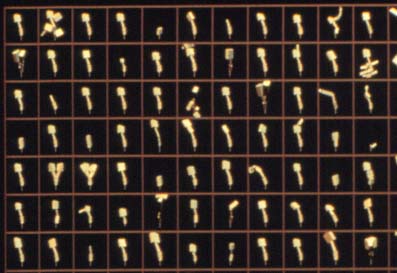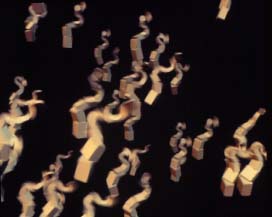 A slightly evolved population of block creatures,
which are being selected for swimming velocity.
A slightly evolved population of block creatures,
which are being selected for swimming velocity.
Sims used a similarly flexible genetic system to specify solutions to the problem of being a ``creature'' built of collections of blocks, linked by flexible joints powered by ``muscles'' controlled by circuits and possibly including sensors [10,11] (Figure 1). Sims embedded these block creatures in simulations of real physics, such as in water, or on a surface. They were then selected for ability at a variety of tasks, such as swimming, swimming after a light source, moving across a surface, and jumping on a surface.
Figure 1: Karl Sims' evolving block creatures.
 A slightly evolved population of block creatures,
which are being selected for swimming velocity.
A slightly evolved population of block creatures,
which are being selected for swimming velocity.
 An evolutionary sequence of creatures selected for swimming
velocity, eventually leading to a snake-like body.
An evolutionary sequence of creatures selected for swimming
velocity, eventually leading to a snake-like body.
 A school of swimming ``water snakes''.
A school of swimming ``water snakes''.
These experiments produced a bewildering and fascinating array of creatures. Some were familiar such as the swimming ``snake'' and walking ``crab'' forms. Others were effective at their tasks, but accomplished them with completely unfamiliar patterns of movement and form. This wild proliferation of forms recalls that which occurred among the animals of the Cambrian explosion (see below), when many more experiments were attempted than have survived to be familiar to us today.
In essence, this work is comparable to a GA or GP, but the genotypes are based on graphs rather than strings or tree structures. Like any optimization, the fitness function is predefined (e.g., maximum swimming velocity). However, the objective of the work was not to find an optimal solution, but rather a diversity of solutions for each fitness function. The design of the system was such that a stunning diversity of solutions was possible and did emerge.
Rather than presenting the results as an optimization curve, showing how performance (e.g., maximum velocity) improves over evolutionary time, Sims presented the results in the style of natural history. He presented the form and behavior of a diversity of evolved individuals.
A loosening of the fitness function took place in an experiment where the objective was to possess a block (Figure 2). Possession of the block involved a competition between two co-evolving populations, tested in individual pairs. Therefore, the form of the competing creature was an evolving part of the fitness landscape. In this case, a large component of the fitness function was outside of the specification of the system. Thus this system exhibits a significant component of natural selection, and allows greater creativity on the part of evolution.
Figure 2: Karl Sims' action sequence of two block creatures competing for possession of a block.
 Finish, the yellow creature on the left wins.
Finish, the yellow creature on the left wins.